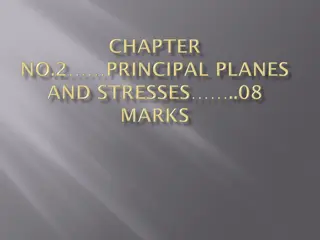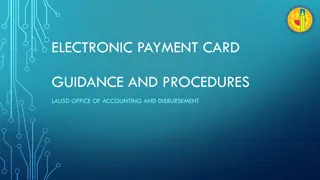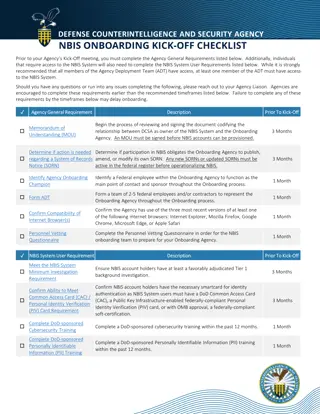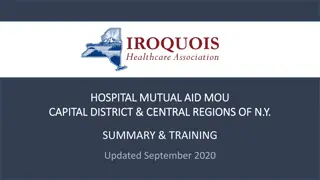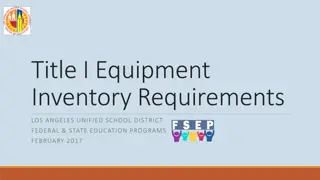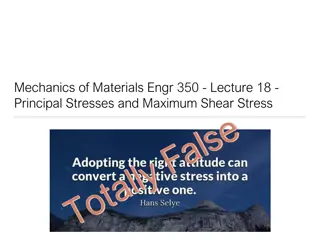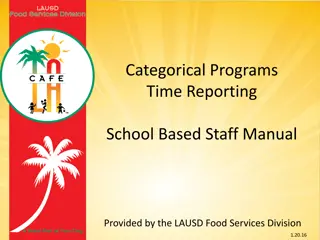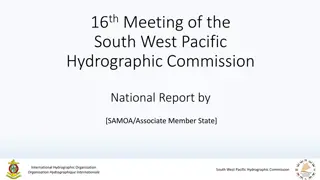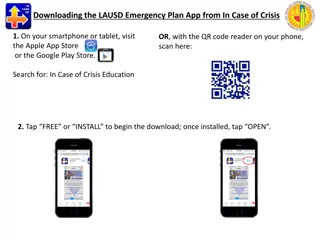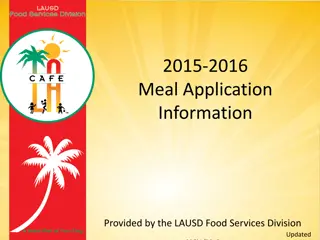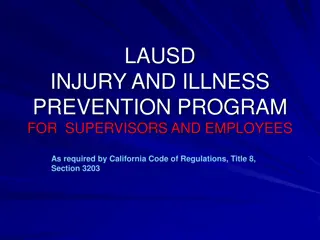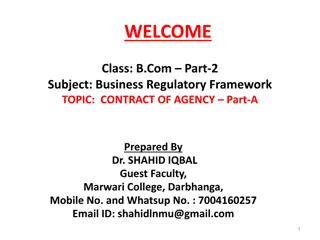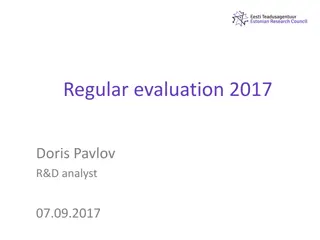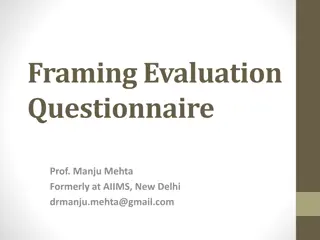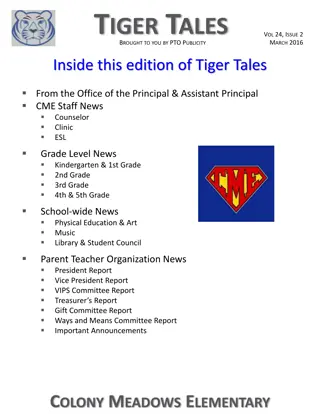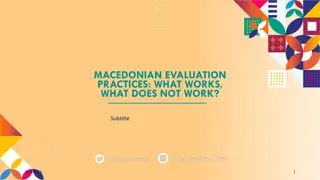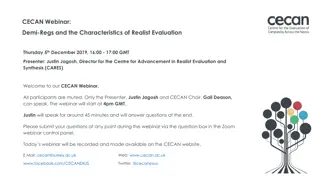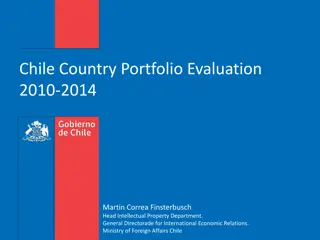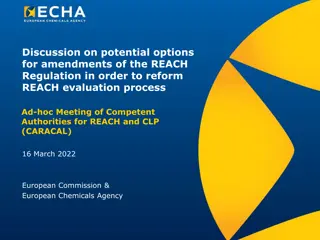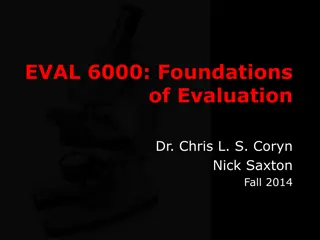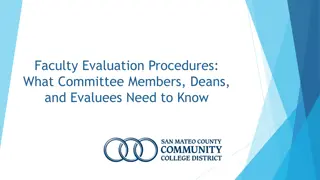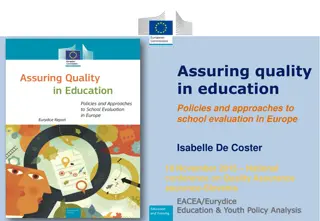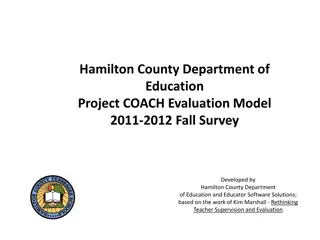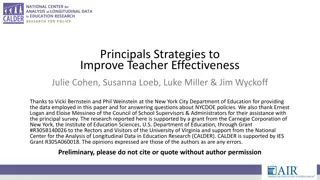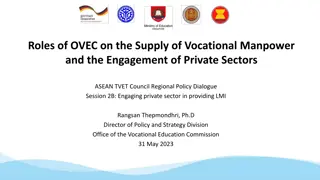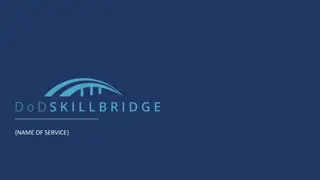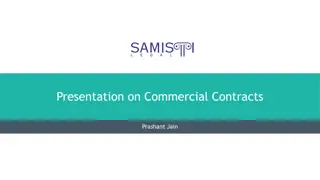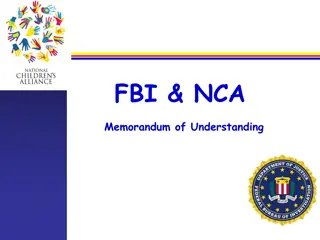LAUSD-AALA Principal Evaluation MOU
Importance of principal performance evaluation, responsibilities for evaluation according to LAUSD policy guide, and understanding between Los Angeles Unified School District and Associated Administrators of Los Angeles regarding the evaluation process at Pilot Schools.
Download Presentation

Please find below an Image/Link to download the presentation.
The content on the website is provided AS IS for your information and personal use only. It may not be sold, licensed, or shared on other websites without obtaining consent from the author. Download presentation by click this link. If you encounter any issues during the download, it is possible that the publisher has removed the file from their server.
E N D
Presentation Transcript
PILOT SCHOOL PRINCIPAL EVALUATION LAUSD-AALA Memorandum of Understanding on Principal Evaluation System
INTRODUCTION Why is principal performance evaluation important? To improve performance; To promote accountability; Encourage professional growth in order to improve the quality of educational services provided by employee; and To provide reasonable assistance to employees whose performance is less than satisfactory. Educators and policymakers agree that principals are critical to school success.
RESPONSIBILITY FOR EVALUATION LAUSD Policy Guide The employee s immediate administrator or designated representative(s) shall be responsible for evaluating the performance of the employee. 2009-2011 AALA Contract The site or unit administrator shall be evaluated by the administrative unit to which the employee reports. If in any individual case the District intends to assign evaluation responsibility to a different administrator, the evaluatee shall be promptly advised in writing as to the identity of the designated evaluator.
Los Angeles Unified School District and Associated Administrators of Los Angeles Agree to this Memorandum of Understanding 1. LAUSD will fully recognize the AALA contractual rights of all AALA members who are assigned to Pilot Schools. 2. Each Pilot School will fully recognize the contractual rights of all AALA members who are assigned to Pilot Schools. LAUSD will send to each Pilot School a copy of this Memorandum of Understanding. 3. LAUSD will take any appropriate action, administrative or otherwise, to protect AALA members who work in Pilot Schools, pursuant to the bargained-for rights under the Collective Bargaining Agreement.
PILOT MANUAL Every Pilot School should have an approved, written process for providing input in to the performance evaluation of the principal. Performance evaluation should take into account the LAUSD-AALA MOU on principal evaluation and be based on the LAUSD School Leadership Framework. Principal is evaluated annually, in accordance with AALA agreement.
How does the MOU Apply to the Evaluation Process? Governing School Council Internal Evaluation Process AALA Contract
Who Participates in the process? Governing School Council Internal Evaluation Subcommittee /Chairperson LD Director Internal Evaluation of Pilot School Principal
Educator Development & Support: School Leader (EDSSL) The School Leadership Framework
SCHOOL LEADERSHIP FOCUS ELEMENTS This year there are 3 common focus elements for Principals and Assistant Principals (District identified) Ensure high-quality professional development Conducts formal and informal observations Provides actionable feedback to staff Each Principal will cooperatively establish, with their Director up to 2 additional focus elements.
Educator Development & Support: School Leader Pilot School Principal Evaluation Process Includes 4 levels for Final Evaluation Principals rated on up to 5 focus elements o District identified (3) o Director and Principal identified (2) Performance Measures o Observation of Practice = 60% o Contribution to Student Outcomes = 20% o Deliberate Practice = 18% o Staff Feedback Surveys = 2% GSC develops evaluation process Process developed in collaboration with Director Written evaluations are submitted to LD Superintendent or Designee LD Superintendent has final authority on evaluation recommendations
Completion Dates for the Educator Development and Support: School Leaders (EDSSL) Cycle Self-Assessment, 8/26/2016 End-of-Year Conference and Final Evaluation, 5/10/2017 Initial Growth Plan, 9/1/2016 End-of-Year Reflection, 4/28/2017 IGP conference, 9/16/2016 Visits, ongoing Visits, ongoing Mid-Year Conference & Formative Rating, 1/31/2017 Mid-Year Self-Reflection, 1/20/2017
Role of the Governing School Council (GSC)
Role of the Governing School Council Establish an internal process for principal evaluation in accordance with the AALA agreement Form the Evaluation Subcommittee to oversee the internal evaluation of the principal Ensure that timelines are met as specified by the Evaluation Subcommittee Ensure that the evaluation report is submitted to the LD Director by April 10 May 1st is the final date for the LD Director to submit the report to the District. This means the timeline should take into account time needed for the LD Superintendent to review the Evaluation Subcommittee s final evaluation report and any changes or additional evaluation the he/she may deem necessary.
Role of the Governing School Council Evaluate the principal Ensure that an annual internal evaluation is completed in accordance with the timelines Ensure regular communication with the LD Director throughout this phase Write an evaluation report Submit the final internal evaluation report to the LD Director Must plan on giving enough time for an additional evaluation should the LD Superintendent deem it necessary.
Role of the Internal Evaluation Subcommittee & Chairperson
Composition of the Internal Evaluation Subcommittee Internal Evaluation Subcommittee LD Director Community Member Teacher Parent Student
Role of the Internal Evaluation Subcommittee Ensures that the timeline for the process is widely communicated; regularly communicates with: LD Director School staff Parents Governing School Council Other Community stakeholders Ensures that the instruments used and the data collected are agreed upon and analyzed
Role of the Internal Evaluation Subcommittee Ensures that the process is carried out with the utmost integrity and confidentiality Meets with the principal to review the findings and recommendations, and agree on next steps and future goals Participates in the training sessions offered by the Office of School Choice and Local Options Oversight Committee to understand the Pilot School Principal Evaluation process
Role of the Internal Evaluation Subcommittee Chairperson Ensures that: There is regular communication with the LD Director throughout the whole process There is a written job description for the principal. There is a written & approved policy for the annual internal evaluation of the principal, as well as annual goals mutually agreed to with the principal. An internal evaluation subcommittee is formed in a timely manner each year. The internal evaluation process is carried out in a timely manner and in accordance with the council s approved evaluation policy. The evaluation s findings and recommendations are written up, approved by the entire council, and submitted by April 10 to the LD Superintendent.
Role of the Local District (LD) Director
Role of the LD Director Support the GSC to develop a comprehensive principal evaluation process. Receive and review the internal evaluation process of the GSC. Meets with the principal at the beginning and end of the process. Ensures that AALA contract timelines are met; submits the final evaluation report to the District by May 1st. Participates in the internal process. Per the AALA Contract, the Superintendent or Designee (LD Director) has the ultimate responsibility for principal evaluation
If the LD Superintendent is not satisfied with the evaluation, he/she may initiate further evaluation of the principal at that time. Enough time should be given for this to happen before May 1st.
INTERNAL EVALUATION TIMELINE Prior to the Start of School Year August - September Meet with Principal to develop 3-4 measurable goals for the school year (consider the goals of the District as well as the mission and vision of the school when establishing goals for the year) Develop a job description for the principal position (if this doesn t already exist for your school) Principal presents goals for the academic school year to the Governing School Council (GSC) and the Local District Meet with LD Director to review the internal evaluation process and gain input as needed EDSSL Cycle: 8/26/16 = self-assessment 9/1/16 = Initial Growth Plan 9/16/16 = IGP conference Develop the internal evaluation process that will be used in the upcoming school year
INTERNAL EVALUATION TIMELINE September - October November - December Governing School Council establishes the internal principal evaluation subcommittee and develops a detailed timeline for the internal evaluation process Governing School Council Chairperson checks in with principal regarding goals, strategies, and evaluation process/timeline Detailed timeline should include period for LD Director review of final report Internal Evaluation Subcommittee will submit and allowance should LD Superintendent want an additional evaluation Evaluation Subcommittee finalizes and organizes surveys, interviews, and other tools for internal principal evaluation process and gets approval from the GSC EDSSL Cycle: Visits are ongoing Internal Evaluation Subcommittee conducts research on and begins to develop the tools and surveys that will be administered as part of the internal evaluation process
INTERNAL EVALUATION TIMELINE January - February March - April Evaluation Subcommittee administers surveys and/or disseminates tools that will be used to collect data relevant to the internal evaluation process ( Final internal evaluation report is presented to the GSC and LD Director for review Evaluation Subcommittee analyzes and synthesizes data received from surveys and other evaluation tools LD Superintendent/Designee acknowledges receipt of the evaluation to both the principal and the chairperson of the GSC LD Superintendent may indicate changes or initiate further evaluation if there are concerns (if more time is needed, may set the above steps earlier than April) Evaluation Subcommittee meets to discuss data and begin writing the final evaluation report EDSSL Cycle: 1/20/17 = Mid-year self-reflection 1/31/17 = Mid-year conference & formative rating Visits, ongoing After any concerns have been addressed, the final report is presented to the principal for review and reflection
INTERNAL EVALUATION TIMELINE March - April EDSSL Cycle: Visits ongoing 4/28/17 = End-of year reflection 5/10/17 = End- of-Year conference & Final Evaluation Principal presents response to the committee s report Final report is submitted by the Instructional Director by May 10th
Gathering Relevant Data for the Internal Principal Evaluation Process Input may include collection of the following data: A self-evaluation or assessment by the principal of his/her performance in relation to the job description and annual goals. Collection of other data, such as review of staff and student engagement and performance data; review of the progress in meeting the annual expectations of the prior year.
The Internal Evaluation Report What can be shared publicly What should remain confidential Materials used (sample of blank questionnaires, surveys) Performance indicators reviewed Data used (not results) Final recommendations Actual evaluation sheets Principal s self-evaluation document Evaluation review between Principal and Evaluation Committee
Questions? Please contact Christina Esguerra at christina.esguerra@lausd.net if you need electronic copies of materials shared today.


